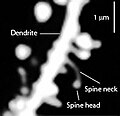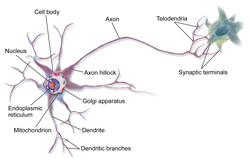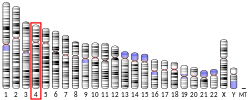Synaptic stabilization is crucial in the developing and adult nervous systems and is considered a result of the late phase of long-term potentiation (LTP)...
26 KB (2,927 words) - 12:39, 17 September 2024
Synapse (redirect from Synaptic inputs)
the synaptic neurons, responding to synaptic activity and, in turn, regulating neurotransmission. Synapses (at least chemical synapses) are stabilized in...
42 KB (4,932 words) - 10:13, 13 May 2025
that form a synaptic association, and is specific to the stimulated pathway of synaptic transmission. The long-term stabilization of synaptic changes is...
30 KB (3,613 words) - 11:48, 17 April 2025
are specialized extracellular matrix structures responsible for synaptic stabilization in the adult brain. PNNs are found around certain neuron cell bodies...
27 KB (3,147 words) - 12:02, 12 January 2025
other genes thought to be involved in LTP, dendritogenesis, and synaptic stabilization. NMDA receptor activation is essential to producing the activity-dependent...
50 KB (5,881 words) - 13:31, 5 May 2025
Neurotransmission (redirect from Synaptic transmission)
propagate along the axon, leading to release of neurotransmitters at the synaptic bouton to pass along information to yet another adjacent neuron. Synthesis...
23 KB (2,723 words) - 15:25, 15 May 2025
cadherins implicates these molecules as major players in the process of synaptic stabilization. Each cadherin exhibits a unique pattern of tissue distribution...
16 KB (1,905 words) - 07:17, 26 April 2024
Long-term potentiation (section Synaptic tagging)
interaction between them in the maintenance of L-LTP. The long-term stabilization of synaptic changes is also determined by a parallel increase of pre- and...
64 KB (7,638 words) - 20:06, 10 May 2025
plasticity mechanisms modify neural synaptic connections selectively, synaptic scaling normalizes all neural synaptic connections by decreasing the strength...
16 KB (2,011 words) - 14:35, 3 December 2023
Memory consolidation (section Synaptic consolidation)
The first, synaptic consolidation, which is thought to correspond to late-phase long-term potentiation, occurs on a small scale in the synaptic connections...
62 KB (7,296 words) - 22:49, 5 May 2025
Synaptogenesis (redirect from Synaptic development)
Besides this, N-cadherin also plays a role in the maturation and stabilization of synaptic specializations. Lastly, N-cadherins help to control dendritic...
55 KB (6,888 words) - 03:17, 21 April 2025
Active zone (redirect from Synaptic active zone)
The active zone or synaptic active zone is a term first used by Couteaux and Pecot-Dechavassinein in 1970 to define the site of neurotransmitter release...
22 KB (2,555 words) - 14:11, 22 November 2022
synaptic vesicles, triggering vesicle fusion with the cell membrane and subsequent neurotransmitter release from the motor neuron into the synaptic cleft...
35 KB (4,084 words) - 07:09, 9 March 2025
Tschida KA, Klein ME, Mooney R (February 2010). "Rapid spine stabilization and synaptic enhancement at the onset of behavioural learning". Nature. 463...
48 KB (5,689 words) - 16:41, 29 December 2024
electric signal from the presynaptic neuron to the target cell through the synaptic gap. Neurons are the main components of nervous tissue in all animals except...
79 KB (9,164 words) - 16:39, 10 May 2025
Homeostatic plasticity (section Synaptic scaling)
variations in synaptic input is known as homeostatic synaptic plasticity. Homeostatic synaptic plasticity occurs when neurons modify their synaptic strength...
30 KB (3,446 words) - 15:35, 1 May 2025
plasticity (STDP) is a biological process that adjusts the strength of synaptic connections between neurons based on the relative timing of their action...
61 KB (7,402 words) - 16:10, 14 May 2025
enhancement of synaptic strength (known as Long-term potentiation (LTP)) and proposed mechanisms that might contribute to allocation at the synaptic level include...
19 KB (2,504 words) - 19:00, 16 August 2023
AMPA receptor (section Synaptic plasticity)
However, at synaptic sites— particularly the postsynaptic density (PSD)—this motion is modulated by retention forces that can transiently stabilize receptors...
75 KB (8,581 words) - 14:22, 3 May 2025
Synaptic tagging, or the synaptic tagging hypothesis, has been proposed to explain how neural signaling at a particular synapse creates a target for subsequent...
21 KB (2,846 words) - 11:47, 7 April 2025
Heterosynaptic plasticity (section Synaptic Scaling)
Heterosynaptic plasticity is a subtype of synaptic plasticity, referring to a chemical synapse's ability to undergo changes in strength, or efficacy of...
22 KB (2,676 words) - 04:33, 16 April 2025
End-plate potential (section Synaptic vesicles)
postsynaptic muscle cell. It stabilizes the postsynaptic acetylcholine receptor clusters, facilitates the transcription of synaptic genes by muscle fiber nuclei...
21 KB (2,781 words) - 23:59, 22 February 2025
potassium channels. It plays an important role in synaptic plasticity and the stabilization of synaptic changes during long-term potentiation. PSD-95 (encoded...
23 KB (2,725 words) - 03:04, 19 December 2023
long-term potentiation (LTP), a well-studied form of synaptic plasticity, and consists of an increase in synaptic strength. LTP could be produced by repetitive...
16 KB (2,308 words) - 11:34, 16 January 2025
The most major effect a mutation could have is on synaptic stabilization. Since the gene limits synaptic plasticity, a mutation may cause issues in proper...
9 KB (1,007 words) - 07:15, 6 January 2025
Tau protein (section Microtubule stabilization)
where it provides microtubule stabilization but also flexibility as needed. Tau proteins interact with tubulin to stabilize microtubules and promote tubulin...
58 KB (6,566 words) - 04:36, 10 February 2025
the SNCA gene. It is a neuronal protein involved in the regulation of synaptic vesicle trafficking and the release of neurotransmitters. Alpha-synuclein...
84 KB (9,572 words) - 22:46, 7 May 2025
selectively weaken specific synapses in order to make constructive use of synaptic strengthening caused by LTP. This is necessary because, if allowed to continue...
53 KB (6,455 words) - 23:27, 21 April 2025
this stabilization increases the likelihood that released glutamate will bind receptors on the postsynaptic neuron. At basal levels of synaptic activity...
21 KB (2,558 words) - 08:17, 1 August 2024
lysosome). The best studied SNAREs are those that mediate the release of synaptic vesicles containing neurotransmitters in neurons. These neuronal SNAREs...
54 KB (6,592 words) - 19:24, 9 February 2025




















